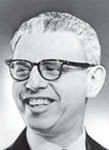|
|
Cleveland and the Freeing of Soviet Jewry | |
|
Involvement in the Soviet Jewry Movement —
by Louis Rosenblum |
||
|
On the National Scene
Kennedy personally arranged for the meeting. As one might expect, Dobrynin denied any problem existed for Jews in the Soviet Union. Kennedy’s assassination on November 22 closed the door for the time being to further help from the administration. Then, on December 19th, at Goldberg’s suggestion, a meeting to discuss the matter of Soviet Jewry was held with representatives of leading American Jewish organizations. He informed them of his concerns and filled them in on his earlier meetings with the President and others. Goldberg presented his conclusion that silence in the matter of Soviet Jewry was not desirable; on the contrary, responsible action was very much in order. Apparently, Goldberg’s meeting with the Jewish establishment reinforced their resolve to get moving on the Soviet Jewry issue. Only a few weeks earlier, prodded by Rabbi Uri Miller and Rabbi Abraham Heschel, the leaders of several American Jewish organizations had met and agreed to bring together resources for public action and education. This, then, was the lead-up to a conference on Soviet Jewry Arthur Goldberg convened in April 1964. The establishment’s difficulties in getting off the dime had to do mainly with organizational prerogatives and jealousies. It would appear that the natural leader of a Soviet Jewry campaign would be one of the defense organizations that proclaim their mission “to defend Jewish interests at home and abroad.” The rub is that in the United States, there are three independent Jewish defense organizations: the American Jewish Committee (AJ Committee), founded 1906; the American Jewish Congress (AJ Congress), founded 1918; and the Anti-Defamation League of the B’nai B’rith (ADL), founded 1913. Each may have seen the Soviet Jewry issue as an opportunity to expand its agenda, its fund raising and its importance — if it had an exclusive lock on the issue. But as for sharing an issue, forget it; over half a century, these organizations had eschewed cooperation, parceling out responsibility or eliminating replication of effort. Other potential leaders — the several Zionists organizations — wanted the Soviet Jewry issue addressed, in the hope that Jews might be permitted to leave the Soviet Union for Israel eventually. But, in general, they were waiting for others to take the lead. While among the religious organizations, Agudas Israel and the Lubavitcher Hasidic movement were deeply concerned about Soviet Jews but were adamant in holding to shtadlonus — quiet diplomacy. Lastly, there was the National Jewish Community Relations Advisory Council (NJCRAC), the umbrella organization that supported local Community Relations Councils (CRC) found in major U.S. cities. Local CRCs, in earlier times, were independent community organizations. Eventually, however, most were subsumed within their local Jewish Community Federation, as in Cleveland. The NJCRAC had a ‘natural’ interest in the Soviet Jewry issue, and was a potentially important player, particularly in coordinating activity at the community level. Among the national Jewish organizations, there was no absence of knowledge of the plight of Soviet Jewry; what was lacking was consensus on who should lead and what should be done — a stalemate. |
|
|
| © 2007 Louis Rosenblum |
